BTEC HND: Leadership & Operations Management Roles & Approaches
VerifiedAdded on 2023/06/15
|15
|4118
|132
Report
AI Summary
This report defines and compares the roles and characteristics of leaders and managers, highlighting their traits, commonalities, and differences. It examines how these roles apply in various organizational contexts and explores different leadership theories and models, including situational leadership, systems leadership, and contingency theory. Furthermore, the report explains key approaches to operations management, such as Total Quality Management (TQM) and Just-in-Time (JIT) inventory, and the roles that leaders and managers play in implementing these strategies within an organization. This document is available on Desklib, a platform offering a variety of study resources including past papers and solved assignments.
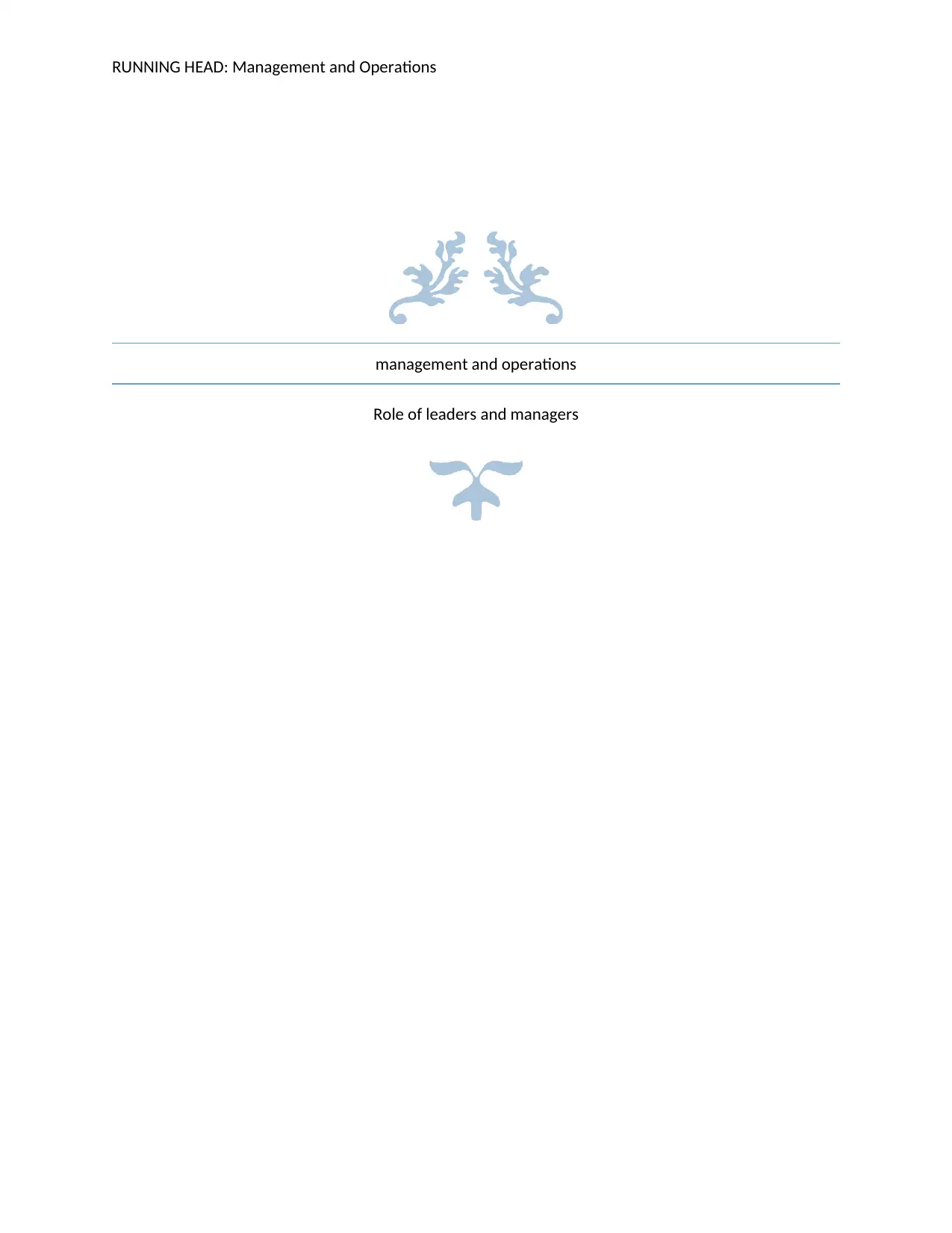
RUNNING HEAD: Management and Operations
management and operations
Role of leaders and managers
management and operations
Role of leaders and managers
Paraphrase This Document
Need a fresh take? Get an instant paraphrase of this document with our AI Paraphraser
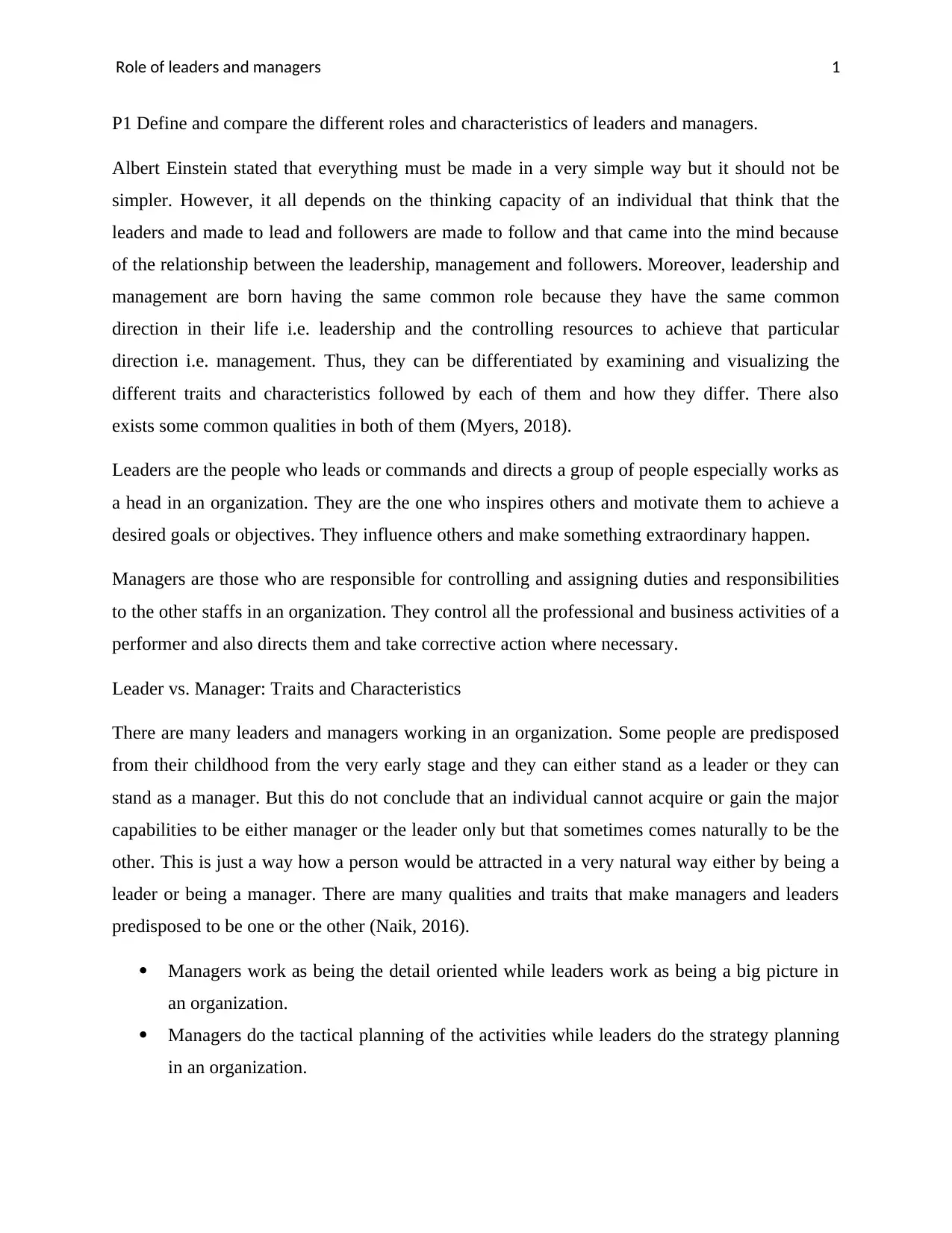
Role of leaders and managers 1
P1 Define and compare the different roles and characteristics of leaders and managers.
Albert Einstein stated that everything must be made in a very simple way but it should not be
simpler. However, it all depends on the thinking capacity of an individual that think that the
leaders and made to lead and followers are made to follow and that came into the mind because
of the relationship between the leadership, management and followers. Moreover, leadership and
management are born having the same common role because they have the same common
direction in their life i.e. leadership and the controlling resources to achieve that particular
direction i.e. management. Thus, they can be differentiated by examining and visualizing the
different traits and characteristics followed by each of them and how they differ. There also
exists some common qualities in both of them (Myers, 2018).
Leaders are the people who leads or commands and directs a group of people especially works as
a head in an organization. They are the one who inspires others and motivate them to achieve a
desired goals or objectives. They influence others and make something extraordinary happen.
Managers are those who are responsible for controlling and assigning duties and responsibilities
to the other staffs in an organization. They control all the professional and business activities of a
performer and also directs them and take corrective action where necessary.
Leader vs. Manager: Traits and Characteristics
There are many leaders and managers working in an organization. Some people are predisposed
from their childhood from the very early stage and they can either stand as a leader or they can
stand as a manager. But this do not conclude that an individual cannot acquire or gain the major
capabilities to be either manager or the leader only but that sometimes comes naturally to be the
other. This is just a way how a person would be attracted in a very natural way either by being a
leader or being a manager. There are many qualities and traits that make managers and leaders
predisposed to be one or the other (Naik, 2016).
Managers work as being the detail oriented while leaders work as being a big picture in
an organization.
Managers do the tactical planning of the activities while leaders do the strategy planning
in an organization.
P1 Define and compare the different roles and characteristics of leaders and managers.
Albert Einstein stated that everything must be made in a very simple way but it should not be
simpler. However, it all depends on the thinking capacity of an individual that think that the
leaders and made to lead and followers are made to follow and that came into the mind because
of the relationship between the leadership, management and followers. Moreover, leadership and
management are born having the same common role because they have the same common
direction in their life i.e. leadership and the controlling resources to achieve that particular
direction i.e. management. Thus, they can be differentiated by examining and visualizing the
different traits and characteristics followed by each of them and how they differ. There also
exists some common qualities in both of them (Myers, 2018).
Leaders are the people who leads or commands and directs a group of people especially works as
a head in an organization. They are the one who inspires others and motivate them to achieve a
desired goals or objectives. They influence others and make something extraordinary happen.
Managers are those who are responsible for controlling and assigning duties and responsibilities
to the other staffs in an organization. They control all the professional and business activities of a
performer and also directs them and take corrective action where necessary.
Leader vs. Manager: Traits and Characteristics
There are many leaders and managers working in an organization. Some people are predisposed
from their childhood from the very early stage and they can either stand as a leader or they can
stand as a manager. But this do not conclude that an individual cannot acquire or gain the major
capabilities to be either manager or the leader only but that sometimes comes naturally to be the
other. This is just a way how a person would be attracted in a very natural way either by being a
leader or being a manager. There are many qualities and traits that make managers and leaders
predisposed to be one or the other (Naik, 2016).
Managers work as being the detail oriented while leaders work as being a big picture in
an organization.
Managers do the tactical planning of the activities while leaders do the strategy planning
in an organization.
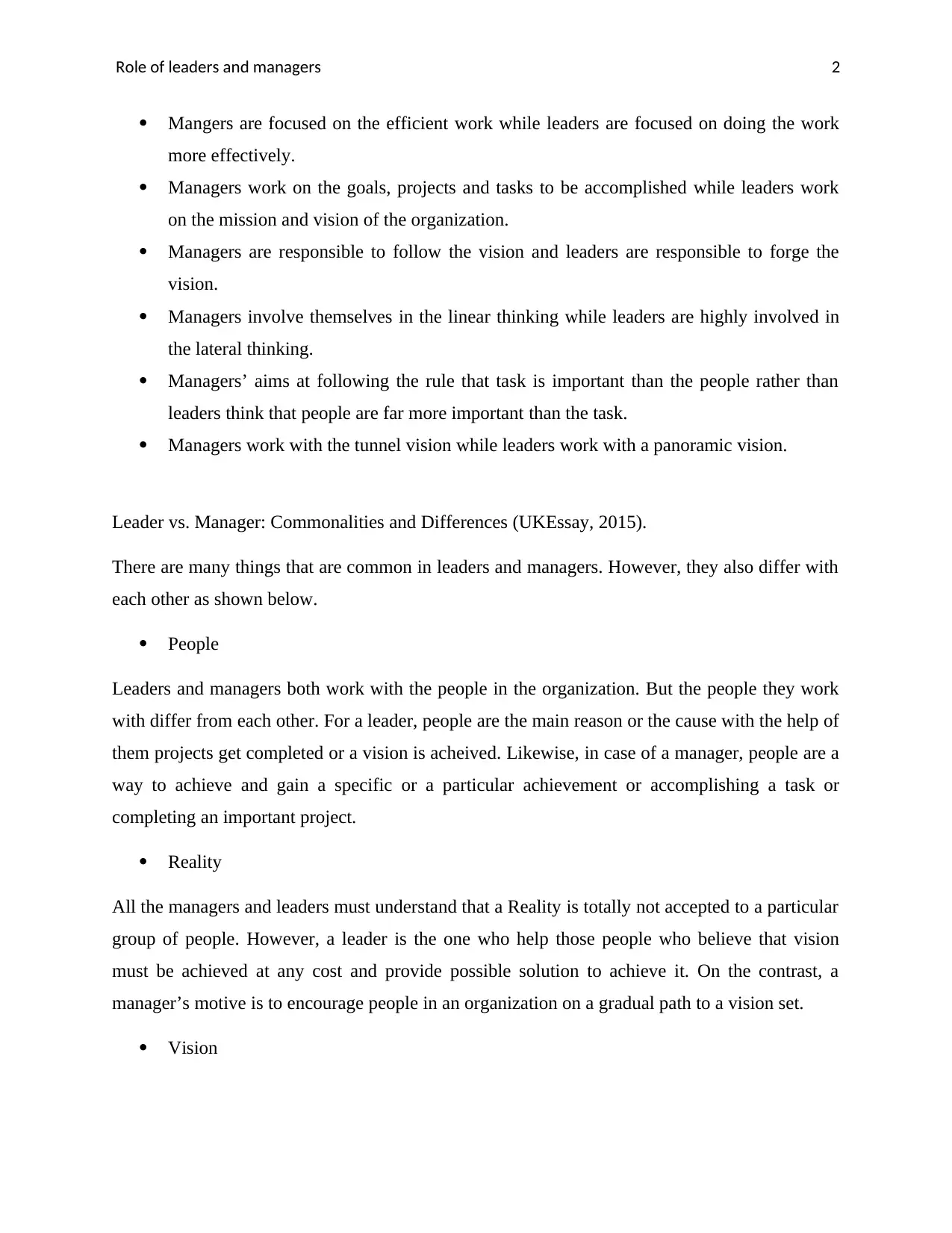
Role of leaders and managers 2
Mangers are focused on the efficient work while leaders are focused on doing the work
more effectively.
Managers work on the goals, projects and tasks to be accomplished while leaders work
on the mission and vision of the organization.
Managers are responsible to follow the vision and leaders are responsible to forge the
vision.
Managers involve themselves in the linear thinking while leaders are highly involved in
the lateral thinking.
Managers’ aims at following the rule that task is important than the people rather than
leaders think that people are far more important than the task.
Managers work with the tunnel vision while leaders work with a panoramic vision.
Leader vs. Manager: Commonalities and Differences (UKEssay, 2015).
There are many things that are common in leaders and managers. However, they also differ with
each other as shown below.
People
Leaders and managers both work with the people in the organization. But the people they work
with differ from each other. For a leader, people are the main reason or the cause with the help of
them projects get completed or a vision is acheived. Likewise, in case of a manager, people are a
way to achieve and gain a specific or a particular achievement or accomplishing a task or
completing an important project.
Reality
All the managers and leaders must understand that a Reality is totally not accepted to a particular
group of people. However, a leader is the one who help those people who believe that vision
must be achieved at any cost and provide possible solution to achieve it. On the contrast, a
manager’s motive is to encourage people in an organization on a gradual path to a vision set.
Vision
Mangers are focused on the efficient work while leaders are focused on doing the work
more effectively.
Managers work on the goals, projects and tasks to be accomplished while leaders work
on the mission and vision of the organization.
Managers are responsible to follow the vision and leaders are responsible to forge the
vision.
Managers involve themselves in the linear thinking while leaders are highly involved in
the lateral thinking.
Managers’ aims at following the rule that task is important than the people rather than
leaders think that people are far more important than the task.
Managers work with the tunnel vision while leaders work with a panoramic vision.
Leader vs. Manager: Commonalities and Differences (UKEssay, 2015).
There are many things that are common in leaders and managers. However, they also differ with
each other as shown below.
People
Leaders and managers both work with the people in the organization. But the people they work
with differ from each other. For a leader, people are the main reason or the cause with the help of
them projects get completed or a vision is acheived. Likewise, in case of a manager, people are a
way to achieve and gain a specific or a particular achievement or accomplishing a task or
completing an important project.
Reality
All the managers and leaders must understand that a Reality is totally not accepted to a particular
group of people. However, a leader is the one who help those people who believe that vision
must be achieved at any cost and provide possible solution to achieve it. On the contrast, a
manager’s motive is to encourage people in an organization on a gradual path to a vision set.
Vision
⊘ This is a preview!⊘
Do you want full access?
Subscribe today to unlock all pages.

Trusted by 1+ million students worldwide
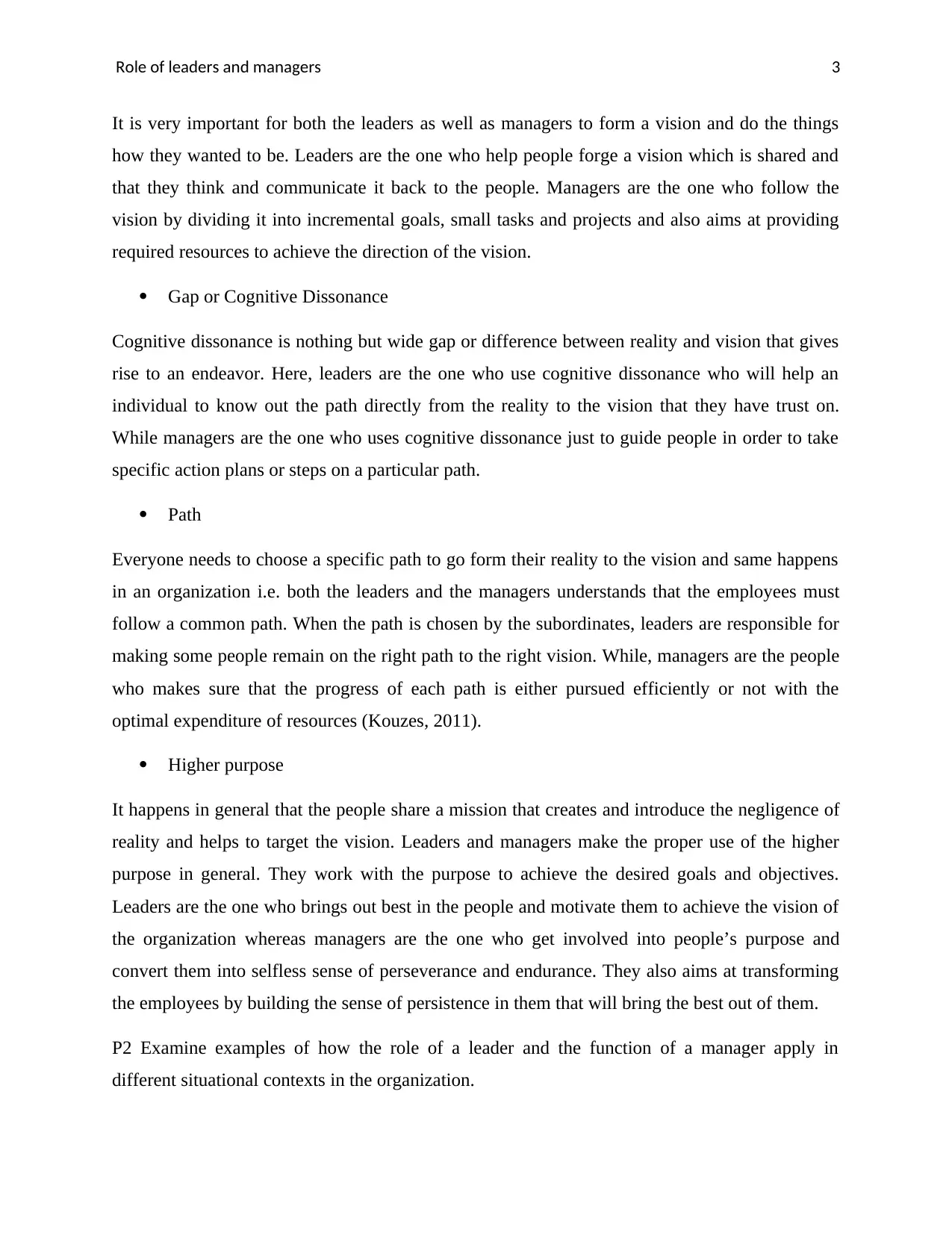
Role of leaders and managers 3
It is very important for both the leaders as well as managers to form a vision and do the things
how they wanted to be. Leaders are the one who help people forge a vision which is shared and
that they think and communicate it back to the people. Managers are the one who follow the
vision by dividing it into incremental goals, small tasks and projects and also aims at providing
required resources to achieve the direction of the vision.
Gap or Cognitive Dissonance
Cognitive dissonance is nothing but wide gap or difference between reality and vision that gives
rise to an endeavor. Here, leaders are the one who use cognitive dissonance who will help an
individual to know out the path directly from the reality to the vision that they have trust on.
While managers are the one who uses cognitive dissonance just to guide people in order to take
specific action plans or steps on a particular path.
Path
Everyone needs to choose a specific path to go form their reality to the vision and same happens
in an organization i.e. both the leaders and the managers understands that the employees must
follow a common path. When the path is chosen by the subordinates, leaders are responsible for
making some people remain on the right path to the right vision. While, managers are the people
who makes sure that the progress of each path is either pursued efficiently or not with the
optimal expenditure of resources (Kouzes, 2011).
Higher purpose
It happens in general that the people share a mission that creates and introduce the negligence of
reality and helps to target the vision. Leaders and managers make the proper use of the higher
purpose in general. They work with the purpose to achieve the desired goals and objectives.
Leaders are the one who brings out best in the people and motivate them to achieve the vision of
the organization whereas managers are the one who get involved into people’s purpose and
convert them into selfless sense of perseverance and endurance. They also aims at transforming
the employees by building the sense of persistence in them that will bring the best out of them.
P2 Examine examples of how the role of a leader and the function of a manager apply in
different situational contexts in the organization.
It is very important for both the leaders as well as managers to form a vision and do the things
how they wanted to be. Leaders are the one who help people forge a vision which is shared and
that they think and communicate it back to the people. Managers are the one who follow the
vision by dividing it into incremental goals, small tasks and projects and also aims at providing
required resources to achieve the direction of the vision.
Gap or Cognitive Dissonance
Cognitive dissonance is nothing but wide gap or difference between reality and vision that gives
rise to an endeavor. Here, leaders are the one who use cognitive dissonance who will help an
individual to know out the path directly from the reality to the vision that they have trust on.
While managers are the one who uses cognitive dissonance just to guide people in order to take
specific action plans or steps on a particular path.
Path
Everyone needs to choose a specific path to go form their reality to the vision and same happens
in an organization i.e. both the leaders and the managers understands that the employees must
follow a common path. When the path is chosen by the subordinates, leaders are responsible for
making some people remain on the right path to the right vision. While, managers are the people
who makes sure that the progress of each path is either pursued efficiently or not with the
optimal expenditure of resources (Kouzes, 2011).
Higher purpose
It happens in general that the people share a mission that creates and introduce the negligence of
reality and helps to target the vision. Leaders and managers make the proper use of the higher
purpose in general. They work with the purpose to achieve the desired goals and objectives.
Leaders are the one who brings out best in the people and motivate them to achieve the vision of
the organization whereas managers are the one who get involved into people’s purpose and
convert them into selfless sense of perseverance and endurance. They also aims at transforming
the employees by building the sense of persistence in them that will bring the best out of them.
P2 Examine examples of how the role of a leader and the function of a manager apply in
different situational contexts in the organization.
Paraphrase This Document
Need a fresh take? Get an instant paraphrase of this document with our AI Paraphraser
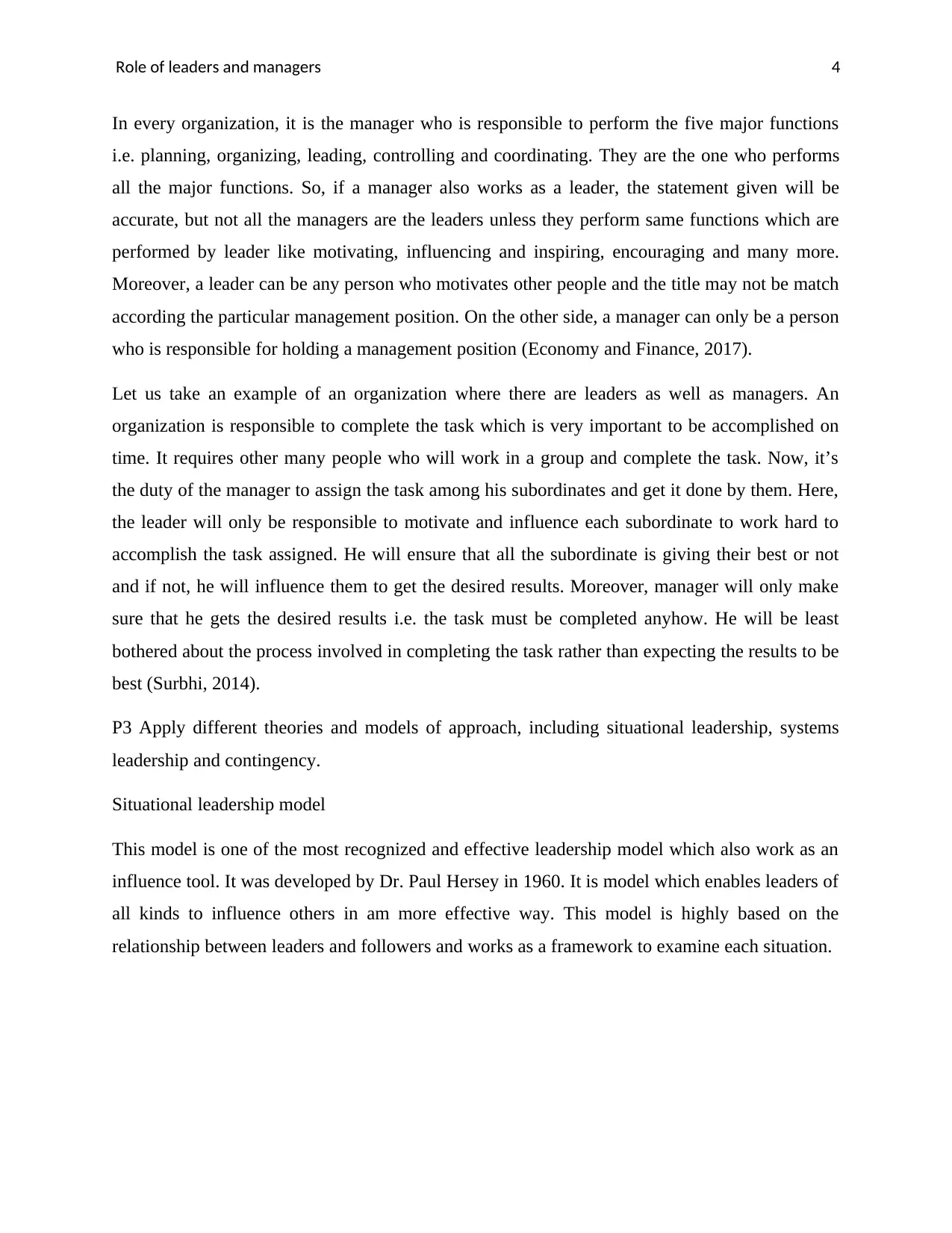
Role of leaders and managers 4
In every organization, it is the manager who is responsible to perform the five major functions
i.e. planning, organizing, leading, controlling and coordinating. They are the one who performs
all the major functions. So, if a manager also works as a leader, the statement given will be
accurate, but not all the managers are the leaders unless they perform same functions which are
performed by leader like motivating, influencing and inspiring, encouraging and many more.
Moreover, a leader can be any person who motivates other people and the title may not be match
according the particular management position. On the other side, a manager can only be a person
who is responsible for holding a management position (Economy and Finance, 2017).
Let us take an example of an organization where there are leaders as well as managers. An
organization is responsible to complete the task which is very important to be accomplished on
time. It requires other many people who will work in a group and complete the task. Now, it’s
the duty of the manager to assign the task among his subordinates and get it done by them. Here,
the leader will only be responsible to motivate and influence each subordinate to work hard to
accomplish the task assigned. He will ensure that all the subordinate is giving their best or not
and if not, he will influence them to get the desired results. Moreover, manager will only make
sure that he gets the desired results i.e. the task must be completed anyhow. He will be least
bothered about the process involved in completing the task rather than expecting the results to be
best (Surbhi, 2014).
P3 Apply different theories and models of approach, including situational leadership, systems
leadership and contingency.
Situational leadership model
This model is one of the most recognized and effective leadership model which also work as an
influence tool. It was developed by Dr. Paul Hersey in 1960. It is model which enables leaders of
all kinds to influence others in am more effective way. This model is highly based on the
relationship between leaders and followers and works as a framework to examine each situation.
In every organization, it is the manager who is responsible to perform the five major functions
i.e. planning, organizing, leading, controlling and coordinating. They are the one who performs
all the major functions. So, if a manager also works as a leader, the statement given will be
accurate, but not all the managers are the leaders unless they perform same functions which are
performed by leader like motivating, influencing and inspiring, encouraging and many more.
Moreover, a leader can be any person who motivates other people and the title may not be match
according the particular management position. On the other side, a manager can only be a person
who is responsible for holding a management position (Economy and Finance, 2017).
Let us take an example of an organization where there are leaders as well as managers. An
organization is responsible to complete the task which is very important to be accomplished on
time. It requires other many people who will work in a group and complete the task. Now, it’s
the duty of the manager to assign the task among his subordinates and get it done by them. Here,
the leader will only be responsible to motivate and influence each subordinate to work hard to
accomplish the task assigned. He will ensure that all the subordinate is giving their best or not
and if not, he will influence them to get the desired results. Moreover, manager will only make
sure that he gets the desired results i.e. the task must be completed anyhow. He will be least
bothered about the process involved in completing the task rather than expecting the results to be
best (Surbhi, 2014).
P3 Apply different theories and models of approach, including situational leadership, systems
leadership and contingency.
Situational leadership model
This model is one of the most recognized and effective leadership model which also work as an
influence tool. It was developed by Dr. Paul Hersey in 1960. It is model which enables leaders of
all kinds to influence others in am more effective way. This model is highly based on the
relationship between leaders and followers and works as a framework to examine each situation.
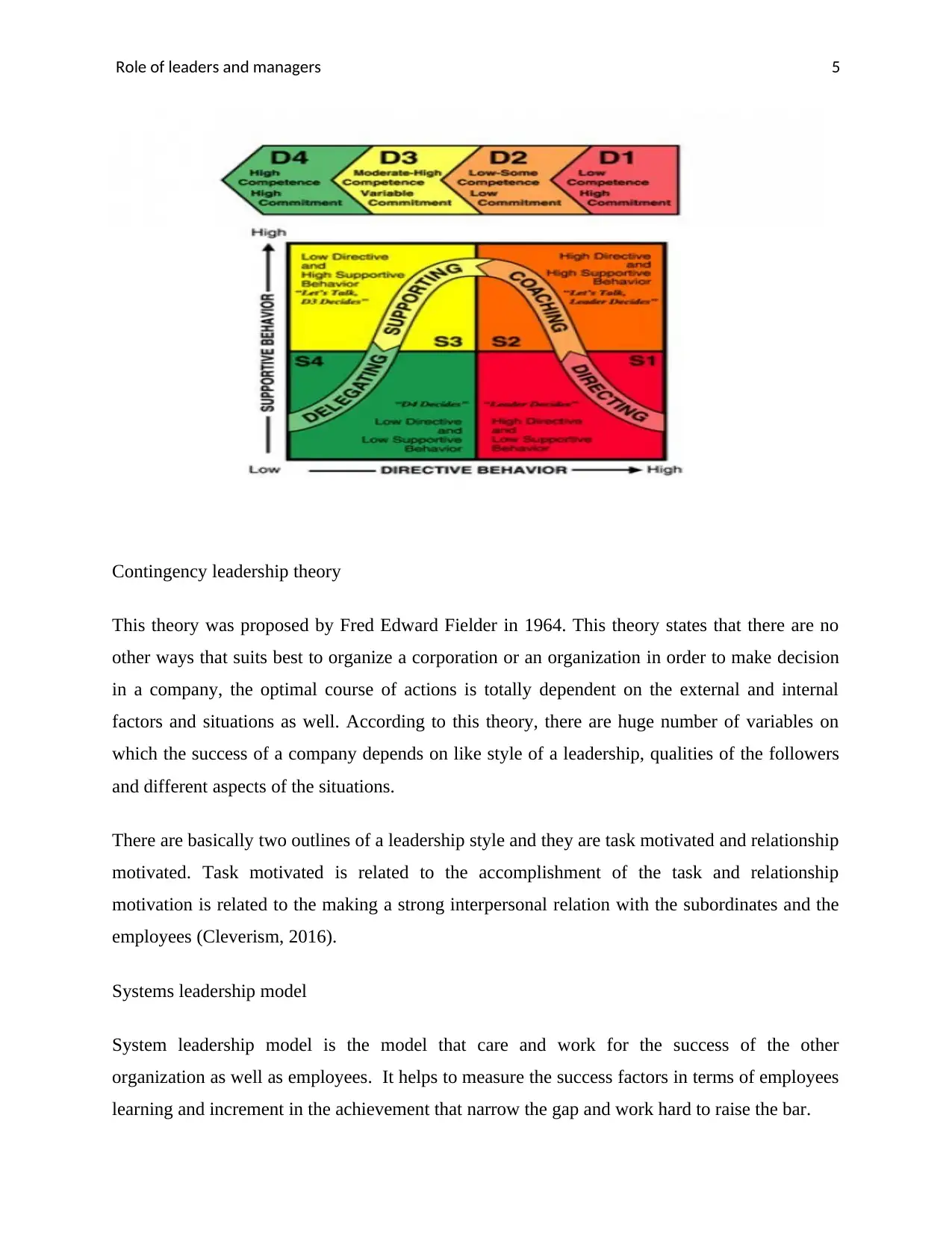
Role of leaders and managers 5
Contingency leadership theory
This theory was proposed by Fred Edward Fielder in 1964. This theory states that there are no
other ways that suits best to organize a corporation or an organization in order to make decision
in a company, the optimal course of actions is totally dependent on the external and internal
factors and situations as well. According to this theory, there are huge number of variables on
which the success of a company depends on like style of a leadership, qualities of the followers
and different aspects of the situations.
There are basically two outlines of a leadership style and they are task motivated and relationship
motivated. Task motivated is related to the accomplishment of the task and relationship
motivation is related to the making a strong interpersonal relation with the subordinates and the
employees (Cleverism, 2016).
Systems leadership model
System leadership model is the model that care and work for the success of the other
organization as well as employees. It helps to measure the success factors in terms of employees
learning and increment in the achievement that narrow the gap and work hard to raise the bar.
Contingency leadership theory
This theory was proposed by Fred Edward Fielder in 1964. This theory states that there are no
other ways that suits best to organize a corporation or an organization in order to make decision
in a company, the optimal course of actions is totally dependent on the external and internal
factors and situations as well. According to this theory, there are huge number of variables on
which the success of a company depends on like style of a leadership, qualities of the followers
and different aspects of the situations.
There are basically two outlines of a leadership style and they are task motivated and relationship
motivated. Task motivated is related to the accomplishment of the task and relationship
motivation is related to the making a strong interpersonal relation with the subordinates and the
employees (Cleverism, 2016).
Systems leadership model
System leadership model is the model that care and work for the success of the other
organization as well as employees. It helps to measure the success factors in terms of employees
learning and increment in the achievement that narrow the gap and work hard to raise the bar.
⊘ This is a preview!⊘
Do you want full access?
Subscribe today to unlock all pages.

Trusted by 1+ million students worldwide
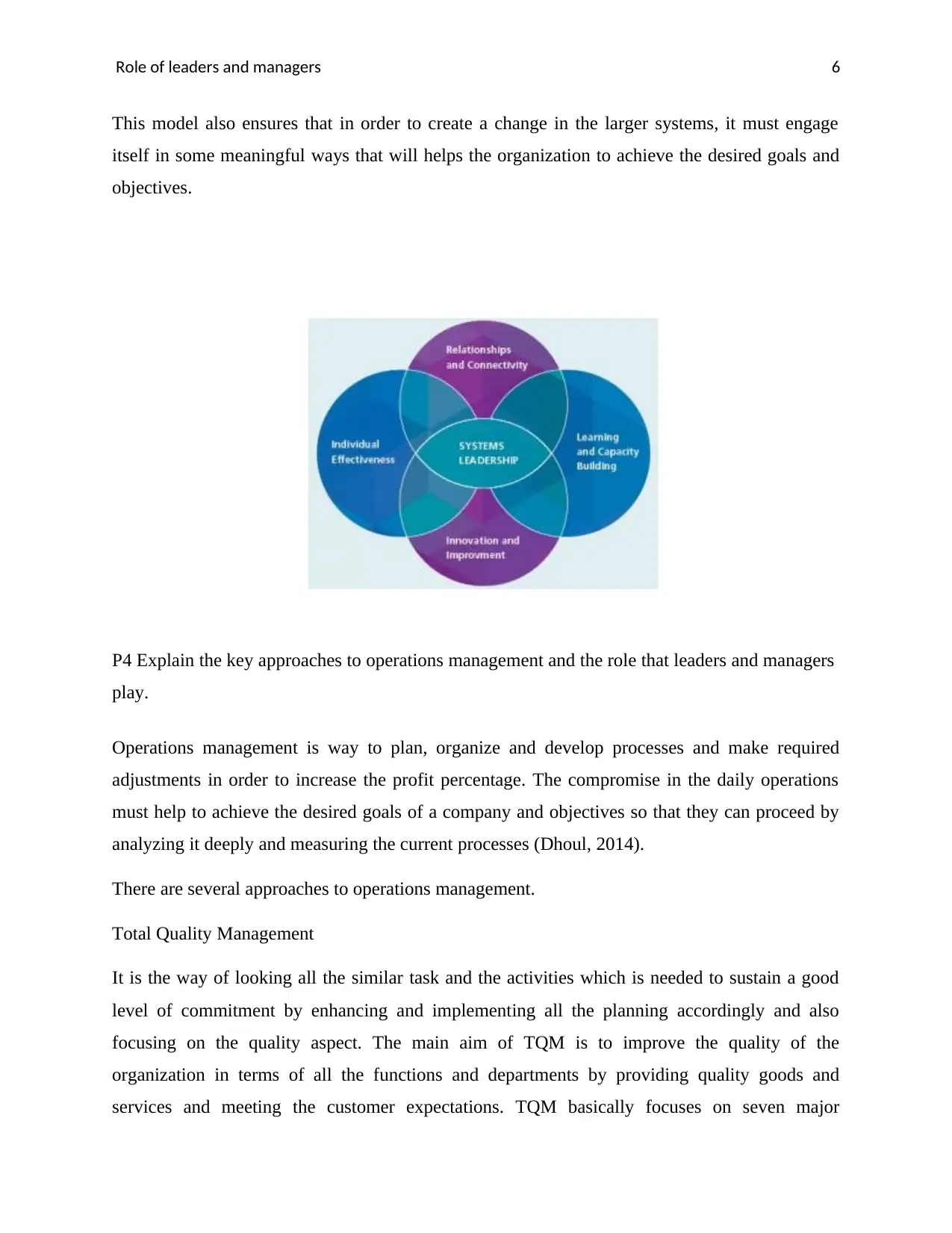
Role of leaders and managers 6
This model also ensures that in order to create a change in the larger systems, it must engage
itself in some meaningful ways that will helps the organization to achieve the desired goals and
objectives.
Operations management is way to plan, organize and develop processes and make required
adjustments in order to increase the profit percentage. The compromise in the daily operations
must help to achieve the desired goals of a company and objectives so that they can proceed by
analyzing it deeply and measuring the current processes (Dhoul, 2014).
There are several approaches to operations management.
Total Quality Management
It is the way of looking all the similar task and the activities which is needed to sustain a good
level of commitment by enhancing and implementing all the planning accordingly and also
focusing on the quality aspect. The main aim of TQM is to improve the quality of the
organization in terms of all the functions and departments by providing quality goods and
services and meeting the customer expectations. TQM basically focuses on seven major
P4 Explain the key approaches to operations management and the role that leaders and managers
play.
This model also ensures that in order to create a change in the larger systems, it must engage
itself in some meaningful ways that will helps the organization to achieve the desired goals and
objectives.
Operations management is way to plan, organize and develop processes and make required
adjustments in order to increase the profit percentage. The compromise in the daily operations
must help to achieve the desired goals of a company and objectives so that they can proceed by
analyzing it deeply and measuring the current processes (Dhoul, 2014).
There are several approaches to operations management.
Total Quality Management
It is the way of looking all the similar task and the activities which is needed to sustain a good
level of commitment by enhancing and implementing all the planning accordingly and also
focusing on the quality aspect. The main aim of TQM is to improve the quality of the
organization in terms of all the functions and departments by providing quality goods and
services and meeting the customer expectations. TQM basically focuses on seven major
P4 Explain the key approaches to operations management and the role that leaders and managers
play.
Paraphrase This Document
Need a fresh take? Get an instant paraphrase of this document with our AI Paraphraser
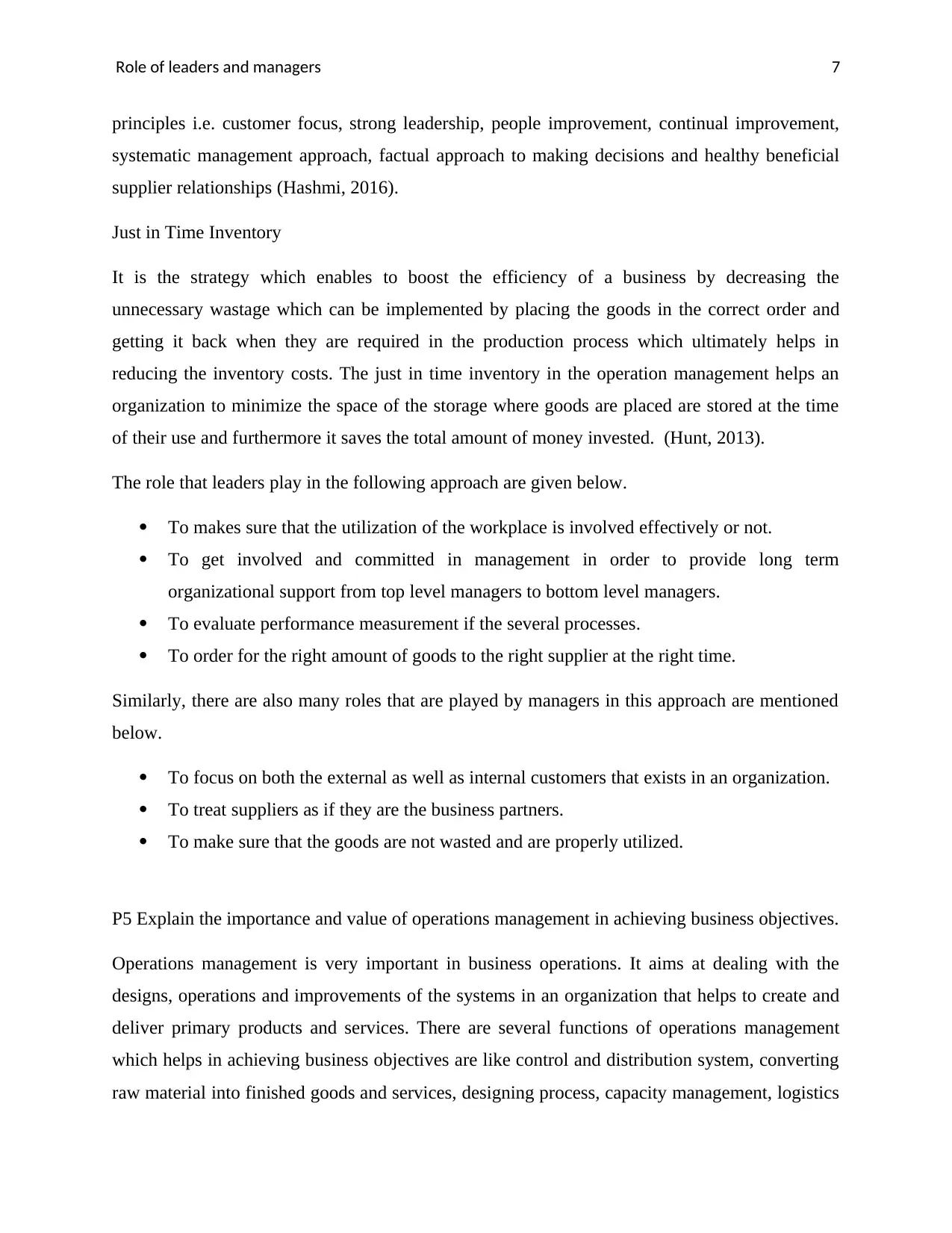
Role of leaders and managers 7
principles i.e. customer focus, strong leadership, people improvement, continual improvement,
systematic management approach, factual approach to making decisions and healthy beneficial
supplier relationships (Hashmi, 2016).
Just in Time Inventory
It is the strategy which enables to boost the efficiency of a business by decreasing the
unnecessary wastage which can be implemented by placing the goods in the correct order and
getting it back when they are required in the production process which ultimately helps in
reducing the inventory costs. The just in time inventory in the operation management helps an
organization to minimize the space of the storage where goods are placed are stored at the time
of their use and furthermore it saves the total amount of money invested. (Hunt, 2013).
The role that leaders play in the following approach are given below.
To makes sure that the utilization of the workplace is involved effectively or not.
To get involved and committed in management in order to provide long term
organizational support from top level managers to bottom level managers.
To evaluate performance measurement if the several processes.
To order for the right amount of goods to the right supplier at the right time.
Similarly, there are also many roles that are played by managers in this approach are mentioned
below.
To focus on both the external as well as internal customers that exists in an organization.
To treat suppliers as if they are the business partners.
To make sure that the goods are not wasted and are properly utilized.
P5 Explain the importance and value of operations management in achieving business objectives.
Operations management is very important in business operations. It aims at dealing with the
designs, operations and improvements of the systems in an organization that helps to create and
deliver primary products and services. There are several functions of operations management
which helps in achieving business objectives are like control and distribution system, converting
raw material into finished goods and services, designing process, capacity management, logistics
principles i.e. customer focus, strong leadership, people improvement, continual improvement,
systematic management approach, factual approach to making decisions and healthy beneficial
supplier relationships (Hashmi, 2016).
Just in Time Inventory
It is the strategy which enables to boost the efficiency of a business by decreasing the
unnecessary wastage which can be implemented by placing the goods in the correct order and
getting it back when they are required in the production process which ultimately helps in
reducing the inventory costs. The just in time inventory in the operation management helps an
organization to minimize the space of the storage where goods are placed are stored at the time
of their use and furthermore it saves the total amount of money invested. (Hunt, 2013).
The role that leaders play in the following approach are given below.
To makes sure that the utilization of the workplace is involved effectively or not.
To get involved and committed in management in order to provide long term
organizational support from top level managers to bottom level managers.
To evaluate performance measurement if the several processes.
To order for the right amount of goods to the right supplier at the right time.
Similarly, there are also many roles that are played by managers in this approach are mentioned
below.
To focus on both the external as well as internal customers that exists in an organization.
To treat suppliers as if they are the business partners.
To make sure that the goods are not wasted and are properly utilized.
P5 Explain the importance and value of operations management in achieving business objectives.
Operations management is very important in business operations. It aims at dealing with the
designs, operations and improvements of the systems in an organization that helps to create and
deliver primary products and services. There are several functions of operations management
which helps in achieving business objectives are like control and distribution system, converting
raw material into finished goods and services, designing process, capacity management, logistics
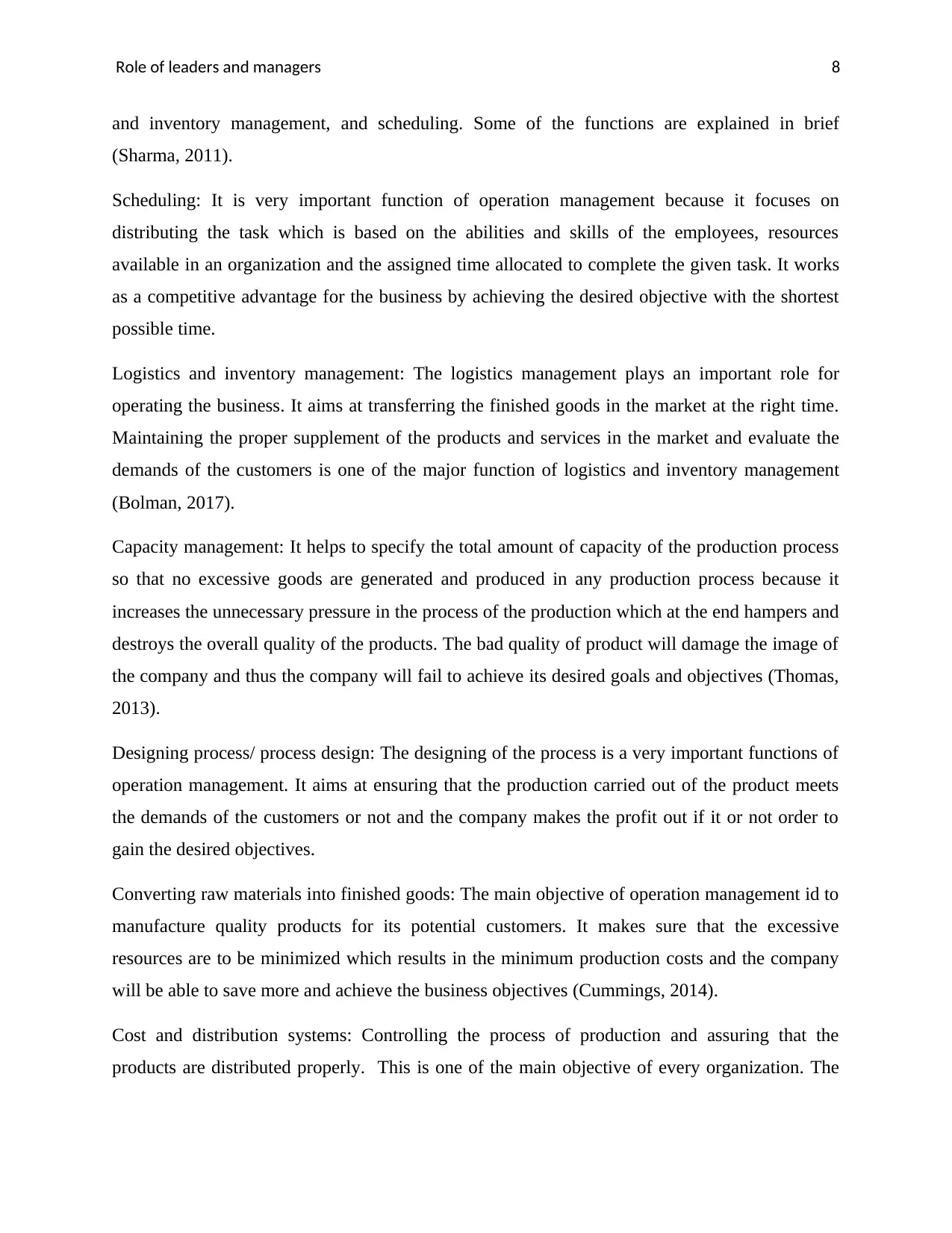
Role of leaders and managers 8
and inventory management, and scheduling. Some of the functions are explained in brief
(Sharma, 2011).
Scheduling: It is very important function of operation management because it focuses on
distributing the task which is based on the abilities and skills of the employees, resources
available in an organization and the assigned time allocated to complete the given task. It works
as a competitive advantage for the business by achieving the desired objective with the shortest
possible time.
Logistics and inventory management: The logistics management plays an important role for
operating the business. It aims at transferring the finished goods in the market at the right time.
Maintaining the proper supplement of the products and services in the market and evaluate the
demands of the customers is one of the major function of logistics and inventory management
(Bolman, 2017).
Capacity management: It helps to specify the total amount of capacity of the production process
so that no excessive goods are generated and produced in any production process because it
increases the unnecessary pressure in the process of the production which at the end hampers and
destroys the overall quality of the products. The bad quality of product will damage the image of
the company and thus the company will fail to achieve its desired goals and objectives (Thomas,
2013).
Designing process/ process design: The designing of the process is a very important functions of
operation management. It aims at ensuring that the production carried out of the product meets
the demands of the customers or not and the company makes the profit out if it or not order to
gain the desired objectives.
Converting raw materials into finished goods: The main objective of operation management id to
manufacture quality products for its potential customers. It makes sure that the excessive
resources are to be minimized which results in the minimum production costs and the company
will be able to save more and achieve the business objectives (Cummings, 2014).
Cost and distribution systems: Controlling the process of production and assuring that the
products are distributed properly. This is one of the main objective of every organization. The
and inventory management, and scheduling. Some of the functions are explained in brief
(Sharma, 2011).
Scheduling: It is very important function of operation management because it focuses on
distributing the task which is based on the abilities and skills of the employees, resources
available in an organization and the assigned time allocated to complete the given task. It works
as a competitive advantage for the business by achieving the desired objective with the shortest
possible time.
Logistics and inventory management: The logistics management plays an important role for
operating the business. It aims at transferring the finished goods in the market at the right time.
Maintaining the proper supplement of the products and services in the market and evaluate the
demands of the customers is one of the major function of logistics and inventory management
(Bolman, 2017).
Capacity management: It helps to specify the total amount of capacity of the production process
so that no excessive goods are generated and produced in any production process because it
increases the unnecessary pressure in the process of the production which at the end hampers and
destroys the overall quality of the products. The bad quality of product will damage the image of
the company and thus the company will fail to achieve its desired goals and objectives (Thomas,
2013).
Designing process/ process design: The designing of the process is a very important functions of
operation management. It aims at ensuring that the production carried out of the product meets
the demands of the customers or not and the company makes the profit out if it or not order to
gain the desired objectives.
Converting raw materials into finished goods: The main objective of operation management id to
manufacture quality products for its potential customers. It makes sure that the excessive
resources are to be minimized which results in the minimum production costs and the company
will be able to save more and achieve the business objectives (Cummings, 2014).
Cost and distribution systems: Controlling the process of production and assuring that the
products are distributed properly. This is one of the main objective of every organization. The
⊘ This is a preview!⊘
Do you want full access?
Subscribe today to unlock all pages.

Trusted by 1+ million students worldwide
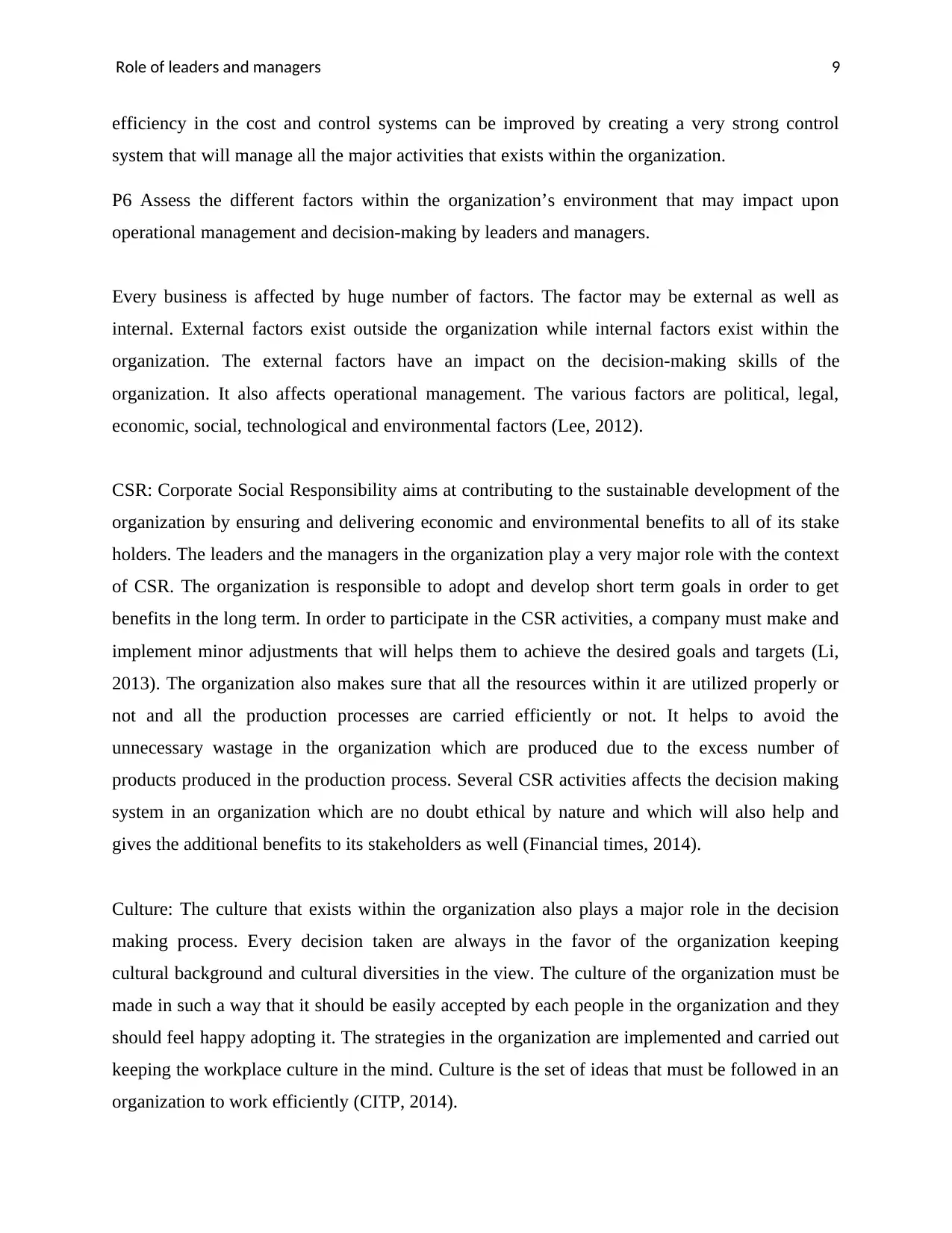
Role of leaders and managers 9
efficiency in the cost and control systems can be improved by creating a very strong control
system that will manage all the major activities that exists within the organization.
P6 Assess the different factors within the organization’s environment that may impact upon
operational management and decision-making by leaders and managers.
Every business is affected by huge number of factors. The factor may be external as well as
internal. External factors exist outside the organization while internal factors exist within the
organization. The external factors have an impact on the decision-making skills of the
organization. It also affects operational management. The various factors are political, legal,
economic, social, technological and environmental factors (Lee, 2012).
CSR: Corporate Social Responsibility aims at contributing to the sustainable development of the
organization by ensuring and delivering economic and environmental benefits to all of its stake
holders. The leaders and the managers in the organization play a very major role with the context
of CSR. The organization is responsible to adopt and develop short term goals in order to get
benefits in the long term. In order to participate in the CSR activities, a company must make and
implement minor adjustments that will helps them to achieve the desired goals and targets (Li,
2013). The organization also makes sure that all the resources within it are utilized properly or
not and all the production processes are carried efficiently or not. It helps to avoid the
unnecessary wastage in the organization which are produced due to the excess number of
products produced in the production process. Several CSR activities affects the decision making
system in an organization which are no doubt ethical by nature and which will also help and
gives the additional benefits to its stakeholders as well (Financial times, 2014).
Culture: The culture that exists within the organization also plays a major role in the decision
making process. Every decision taken are always in the favor of the organization keeping
cultural background and cultural diversities in the view. The culture of the organization must be
made in such a way that it should be easily accepted by each people in the organization and they
should feel happy adopting it. The strategies in the organization are implemented and carried out
keeping the workplace culture in the mind. Culture is the set of ideas that must be followed in an
organization to work efficiently (CITP, 2014).
efficiency in the cost and control systems can be improved by creating a very strong control
system that will manage all the major activities that exists within the organization.
P6 Assess the different factors within the organization’s environment that may impact upon
operational management and decision-making by leaders and managers.
Every business is affected by huge number of factors. The factor may be external as well as
internal. External factors exist outside the organization while internal factors exist within the
organization. The external factors have an impact on the decision-making skills of the
organization. It also affects operational management. The various factors are political, legal,
economic, social, technological and environmental factors (Lee, 2012).
CSR: Corporate Social Responsibility aims at contributing to the sustainable development of the
organization by ensuring and delivering economic and environmental benefits to all of its stake
holders. The leaders and the managers in the organization play a very major role with the context
of CSR. The organization is responsible to adopt and develop short term goals in order to get
benefits in the long term. In order to participate in the CSR activities, a company must make and
implement minor adjustments that will helps them to achieve the desired goals and targets (Li,
2013). The organization also makes sure that all the resources within it are utilized properly or
not and all the production processes are carried efficiently or not. It helps to avoid the
unnecessary wastage in the organization which are produced due to the excess number of
products produced in the production process. Several CSR activities affects the decision making
system in an organization which are no doubt ethical by nature and which will also help and
gives the additional benefits to its stakeholders as well (Financial times, 2014).
Culture: The culture that exists within the organization also plays a major role in the decision
making process. Every decision taken are always in the favor of the organization keeping
cultural background and cultural diversities in the view. The culture of the organization must be
made in such a way that it should be easily accepted by each people in the organization and they
should feel happy adopting it. The strategies in the organization are implemented and carried out
keeping the workplace culture in the mind. Culture is the set of ideas that must be followed in an
organization to work efficiently (CITP, 2014).
Paraphrase This Document
Need a fresh take? Get an instant paraphrase of this document with our AI Paraphraser
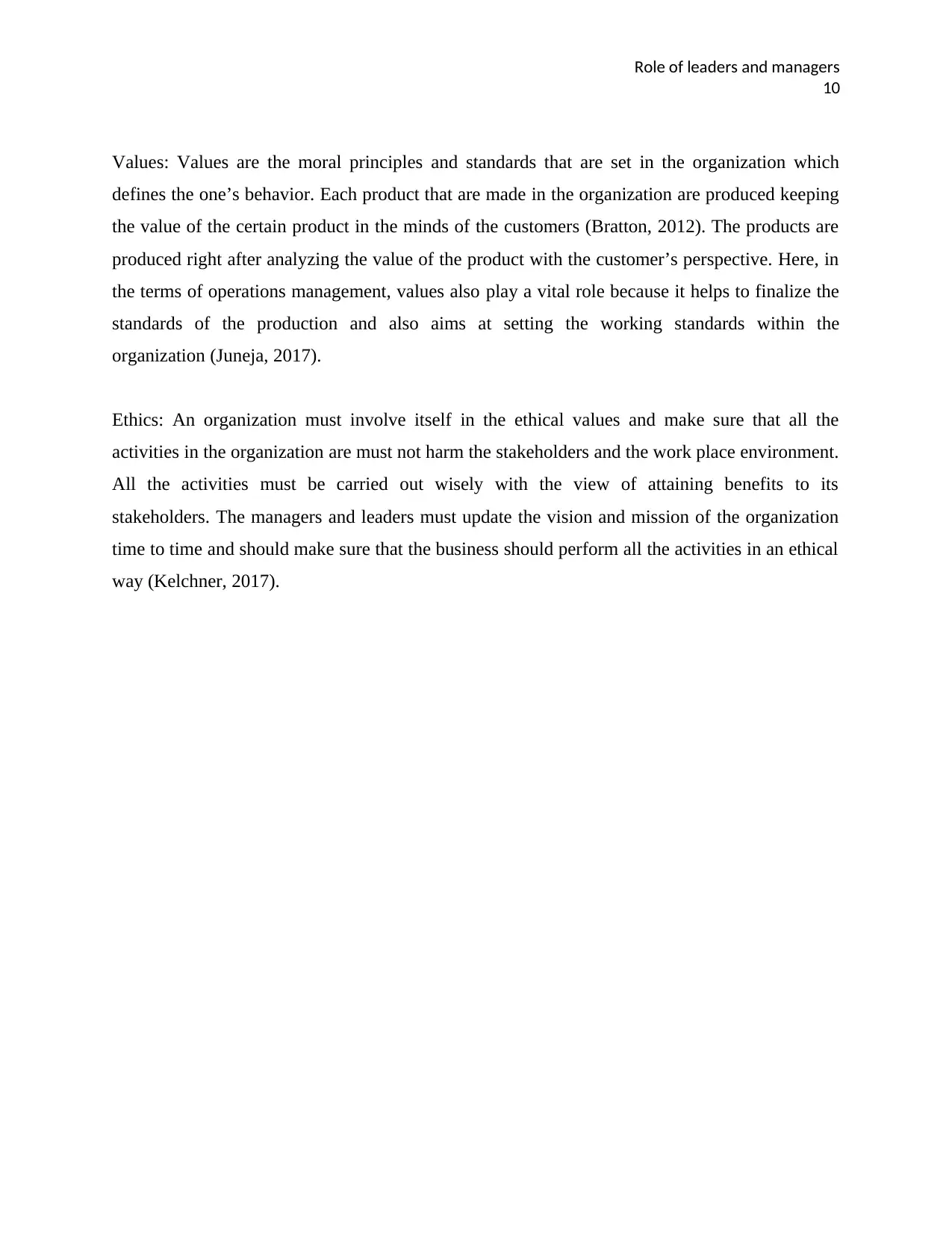
Role of leaders and managers
10
Values: Values are the moral principles and standards that are set in the organization which
defines the one’s behavior. Each product that are made in the organization are produced keeping
the value of the certain product in the minds of the customers (Bratton, 2012). The products are
produced right after analyzing the value of the product with the customer’s perspective. Here, in
the terms of operations management, values also play a vital role because it helps to finalize the
standards of the production and also aims at setting the working standards within the
organization (Juneja, 2017).
Ethics: An organization must involve itself in the ethical values and make sure that all the
activities in the organization are must not harm the stakeholders and the work place environment.
All the activities must be carried out wisely with the view of attaining benefits to its
stakeholders. The managers and leaders must update the vision and mission of the organization
time to time and should make sure that the business should perform all the activities in an ethical
way (Kelchner, 2017).
10
Values: Values are the moral principles and standards that are set in the organization which
defines the one’s behavior. Each product that are made in the organization are produced keeping
the value of the certain product in the minds of the customers (Bratton, 2012). The products are
produced right after analyzing the value of the product with the customer’s perspective. Here, in
the terms of operations management, values also play a vital role because it helps to finalize the
standards of the production and also aims at setting the working standards within the
organization (Juneja, 2017).
Ethics: An organization must involve itself in the ethical values and make sure that all the
activities in the organization are must not harm the stakeholders and the work place environment.
All the activities must be carried out wisely with the view of attaining benefits to its
stakeholders. The managers and leaders must update the vision and mission of the organization
time to time and should make sure that the business should perform all the activities in an ethical
way (Kelchner, 2017).
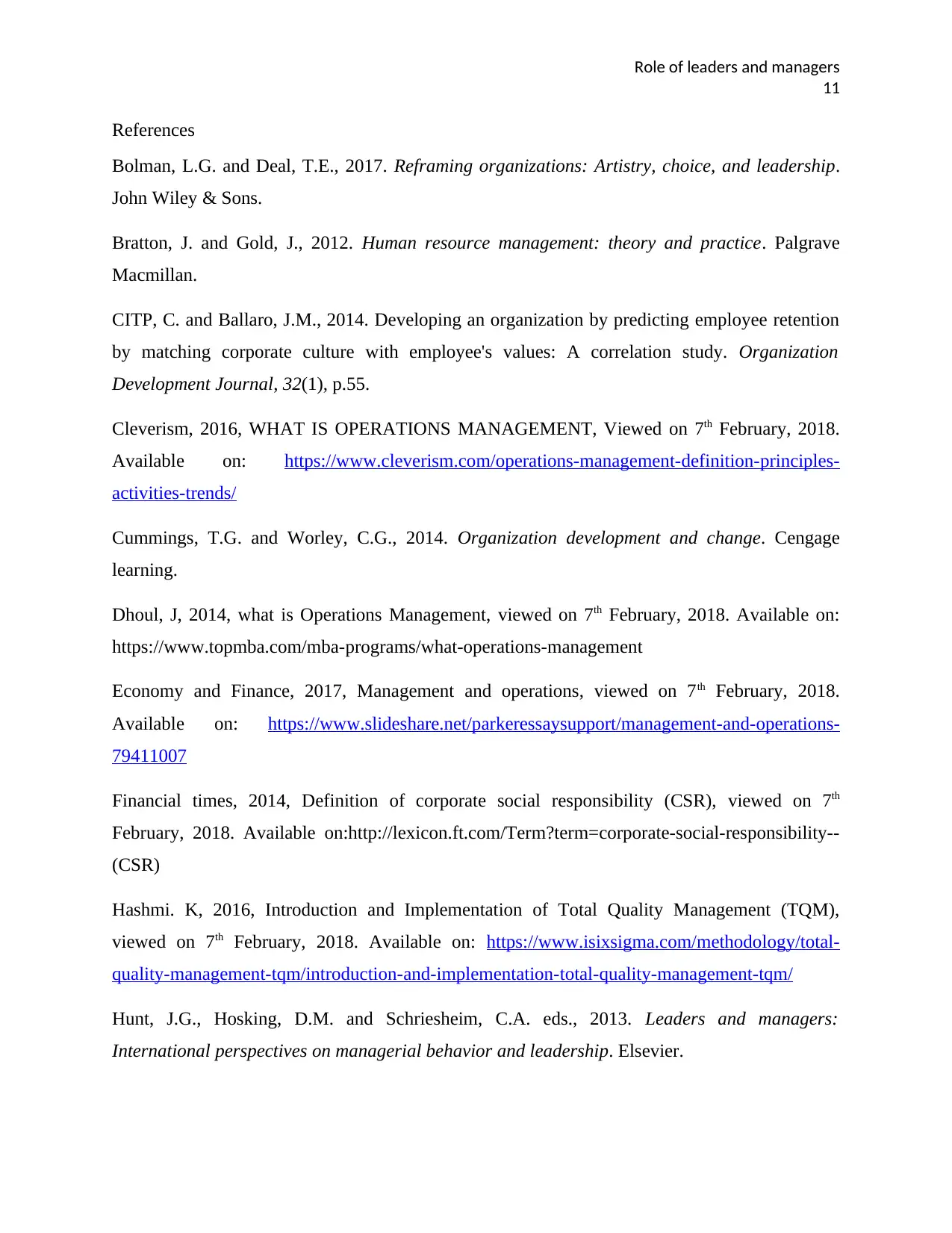
Role of leaders and managers
11
References
Bolman, L.G. and Deal, T.E., 2017. Reframing organizations: Artistry, choice, and leadership.
John Wiley & Sons.
Bratton, J. and Gold, J., 2012. Human resource management: theory and practice. Palgrave
Macmillan.
CITP, C. and Ballaro, J.M., 2014. Developing an organization by predicting employee retention
by matching corporate culture with employee's values: A correlation study. Organization
Development Journal, 32(1), p.55.
Cleverism, 2016, WHAT IS OPERATIONS MANAGEMENT, Viewed on 7th February, 2018.
Available on: https://www.cleverism.com/operations-management-definition-principles-
activities-trends/
Cummings, T.G. and Worley, C.G., 2014. Organization development and change. Cengage
learning.
Dhoul, J, 2014, what is Operations Management, viewed on 7th February, 2018. Available on:
https://www.topmba.com/mba-programs/what-operations-management
Economy and Finance, 2017, Management and operations, viewed on 7th February, 2018.
Available on: https://www.slideshare.net/parkeressaysupport/management-and-operations-
79411007
Financial times, 2014, Definition of corporate social responsibility (CSR), viewed on 7th
February, 2018. Available on:http://lexicon.ft.com/Term?term=corporate-social-responsibility--
(CSR)
Hashmi. K, 2016, Introduction and Implementation of Total Quality Management (TQM),
viewed on 7th February, 2018. Available on: https://www.isixsigma.com/methodology/total-
quality-management-tqm/introduction-and-implementation-total-quality-management-tqm/
Hunt, J.G., Hosking, D.M. and Schriesheim, C.A. eds., 2013. Leaders and managers:
International perspectives on managerial behavior and leadership. Elsevier.
11
References
Bolman, L.G. and Deal, T.E., 2017. Reframing organizations: Artistry, choice, and leadership.
John Wiley & Sons.
Bratton, J. and Gold, J., 2012. Human resource management: theory and practice. Palgrave
Macmillan.
CITP, C. and Ballaro, J.M., 2014. Developing an organization by predicting employee retention
by matching corporate culture with employee's values: A correlation study. Organization
Development Journal, 32(1), p.55.
Cleverism, 2016, WHAT IS OPERATIONS MANAGEMENT, Viewed on 7th February, 2018.
Available on: https://www.cleverism.com/operations-management-definition-principles-
activities-trends/
Cummings, T.G. and Worley, C.G., 2014. Organization development and change. Cengage
learning.
Dhoul, J, 2014, what is Operations Management, viewed on 7th February, 2018. Available on:
https://www.topmba.com/mba-programs/what-operations-management
Economy and Finance, 2017, Management and operations, viewed on 7th February, 2018.
Available on: https://www.slideshare.net/parkeressaysupport/management-and-operations-
79411007
Financial times, 2014, Definition of corporate social responsibility (CSR), viewed on 7th
February, 2018. Available on:http://lexicon.ft.com/Term?term=corporate-social-responsibility--
(CSR)
Hashmi. K, 2016, Introduction and Implementation of Total Quality Management (TQM),
viewed on 7th February, 2018. Available on: https://www.isixsigma.com/methodology/total-
quality-management-tqm/introduction-and-implementation-total-quality-management-tqm/
Hunt, J.G., Hosking, D.M. and Schriesheim, C.A. eds., 2013. Leaders and managers:
International perspectives on managerial behavior and leadership. Elsevier.
⊘ This is a preview!⊘
Do you want full access?
Subscribe today to unlock all pages.

Trusted by 1+ million students worldwide
1 out of 15
Related Documents
Your All-in-One AI-Powered Toolkit for Academic Success.
+13062052269
info@desklib.com
Available 24*7 on WhatsApp / Email
![[object Object]](/_next/static/media/star-bottom.7253800d.svg)
Unlock your academic potential
Copyright © 2020–2025 A2Z Services. All Rights Reserved. Developed and managed by ZUCOL.


